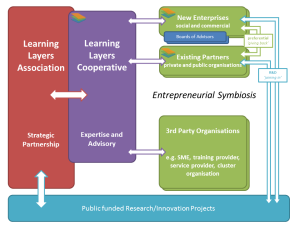Possible use of Learning Toolbox in Bau-ABC training – three exemplary cases
Last week we had two working visits to the training centre Bau-ABC in the contexts of our EU-funded Learning Layers (LL) project. The aim of these visits was firstly to clarify, in what kinds of projects Bau-ABC trainers (Lehrwerkmeister) have planned to use Learning Toolbox (LTB) in the forthcoming pilot phase. Secondly we wanted to clarify what measures need to be taken to facilitate the Internet access in Bau-ABC. Thirdly we wanted to clarify, how to link third party apps or complementary tools to LTB to meet specific needs. The two latter points have been covered by internal notes. The first point merits public attention, therefore this blog gives a quick overview on the plans of Bau-ABC trainers.
During the two visits the Bau-ABC trainers presented three exemplary cases for implementing LTB in their training. The first case (developed together with Lothar Schoka) focuses on apprentices projects in trade of well-builders (Brunnenbauer). The second case (developed together with Thomas Weertz) deals with training materials and facilitation of learning in the transversal area ‘health and safety’ (Arbeitssicherheit und Gesundheitsschutz). During the second working visit a third case was brought to picture by Markus Pape and Kevin Kuck – a joint project of Carpenters (Zimmerer) and Bricklayers (Maurer).
a) The Brunnenbauer-pilot is adjusted to the start of a new group in Bau-ABC and the introduction of the LTB comes along with their induction to project-based learning. The use of LTB will not cover entirely the documentation of project work of apprentices (plans, reports, certificates) but will support it. The main thrust for the trainer is to provide support material (Zusatzmaterial, e.g. Extracts of relevant DIN-norms). Also, the work of apprentices can be supported with digital worksheets (lists of tools and materials) that can be produced with the help of apps made available via LTB. Here, the apprentices could present digital interim versions and get feedback before completing the projects. As a use-case for two-way communication, Schoka indicated that apprentices can produce and share photo sets of construction sites of their companies as eventual targets for on-site-visits of the whole group.
b) Concerning the theme “Arbeitssicherheit und Gesundheitsschutz”, the competent body in the construction sector (BG Bau) has produced a comprehensive set of modularised reference materials (Baukasten) and a special program for young craftsmen. In addition to these, Bau-ABC uses a special compendium for trainers (KomPass). These materials are available on the net. In addition, in each of their projects the apprentices are required to fill a risk analysis form regarding possible occupational hazards with the tasks (Gefährdungsbeurteilung). The advantage of using LTB with this theme is that it enables delivery of compressed information (checklists, extracts of information sheets, model solutions with feedback) as well use of Quiz tools (ordinary quiz or detecting errors).
c) The joint project of Zimmerer and Maurer was based on the traditional technique of building houses with wooden frames and brick walls (Fachwerkhaus). Bau-ABC projects with smaller constructions using that technique serve as cooperation exercises between these two trades. By using LTB and creating a joint stack it is possible to
- give an overview on the common project (as a whole),
- on related standards,
- to distribute the tasks between the trades
- to organise the boundary-crossing exercises of Zimmerer and Maurer in each others’ tasks and to
- coordinate the collaboration between the two trades.
After these working visits we are heading towards the pilots in the coming weeks and arranging the necessary support. We will report more on the pilots when we take further steps with the implementation.
More blogs to come …

